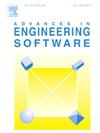Form finding of cable-membrane structures with flexible frames: Finite element implementation and application to surface accuracy analysis of umbrella-like rib-mesh reflectors
IF 4
2区 工程技术
Q2 COMPUTER SCIENCE, INTERDISCIPLINARY APPLICATIONS
引用次数: 0
Abstract
Deployable rib-mesh reflector antennas, known for their ultralight nature and high deployment-to-stowage ratio, have been attracting attention from both the aerospace industry and academia. Form finding is a critical step in determining the equilibrium shape of the reflector under a specific internal stress distribution, which is a prerequisite in evaluating the surface accuracy of these antennas. This paper presents a comprehensive methodology for iteratively implementing the nonlinear finite element method for form finding of cable-membrane structures supported by flexible frames. The method is integrated into the commercial finite element code ABAQUS with Python scripts, and its accuracy and efficiency are validated through a few benchmark examples. Subsequently, the proposed method is applied to analyze the surface accuracy of umbrella-like rib-mesh reflector antennas. The effect of key design parameters such as the number and rigidity of ribs, the magnitude and anisotropy of membrane stress, and the amount of pretension force in boundary cables on the antenna’s surface accuracy has been highlighted. The effort not only establishes a robust and user-friendly strategy for form finding of cable-membrane structures supported by flexible frames but also provides valuable insights into the surface accuracy of umbrella-like rib-mesh reflector antennas. To facilitate the application of the FEM-based form-finding method, the source code for this paper is publicly available via a permanent link on GitHub https://github.com/SCU-An-Group/FEM-based-Form-Finding.
带柔性框架的索膜结构的形状搜索:有限元实施及应用于伞状肋网反射器表面精度分析
可部署的肋网反射天线以其超轻特性和高部署-存储比而著称,一直受到航空航天工业和学术界的关注。形状搜索是确定特定内应力分布下反射器平衡形状的关键步骤,也是评估这些天线表面精度的先决条件。本文介绍了一种迭代实施非线性有限元方法的综合方法,用于对由柔性框架支撑的索膜结构进行形状搜索。该方法通过 Python 脚本集成到商用有限元代码 ABAQUS 中,并通过几个基准示例验证了其精度和效率。随后,提出的方法被用于分析伞状肋网反射天线的表面精度。重点分析了关键设计参数,如肋的数量和刚度、膜应力的大小和各向异性,以及边界电缆预拉力的大小对天线表面精度的影响。这项工作不仅为由柔性框架支撑的索膜结构的形状查找建立了一个稳健且用户友好的策略,而且为伞状肋网反射天线的表面精度提供了宝贵的见解。为便于应用基于有限元的形状搜索方法,本文的源代码通过 GitHub https://github.com/SCU-An-Group/FEM-based-Form-Finding 上的永久链接公开发布。
本文章由计算机程序翻译,如有差异,请以英文原文为准。
求助全文
约1分钟内获得全文
求助全文
来源期刊

Advances in Engineering Software
工程技术-计算机:跨学科应用
CiteScore
7.70
自引率
4.20%
发文量
169
审稿时长
37 days
期刊介绍:
The objective of this journal is to communicate recent and projected advances in computer-based engineering techniques. The fields covered include mechanical, aerospace, civil and environmental engineering, with an emphasis on research and development leading to practical problem-solving.
The scope of the journal includes:
• Innovative computational strategies and numerical algorithms for large-scale engineering problems
• Analysis and simulation techniques and systems
• Model and mesh generation
• Control of the accuracy, stability and efficiency of computational process
• Exploitation of new computing environments (eg distributed hetergeneous and collaborative computing)
• Advanced visualization techniques, virtual environments and prototyping
• Applications of AI, knowledge-based systems, computational intelligence, including fuzzy logic, neural networks and evolutionary computations
• Application of object-oriented technology to engineering problems
• Intelligent human computer interfaces
• Design automation, multidisciplinary design and optimization
• CAD, CAE and integrated process and product development systems
• Quality and reliability.
 求助内容:
求助内容: 应助结果提醒方式:
应助结果提醒方式:


